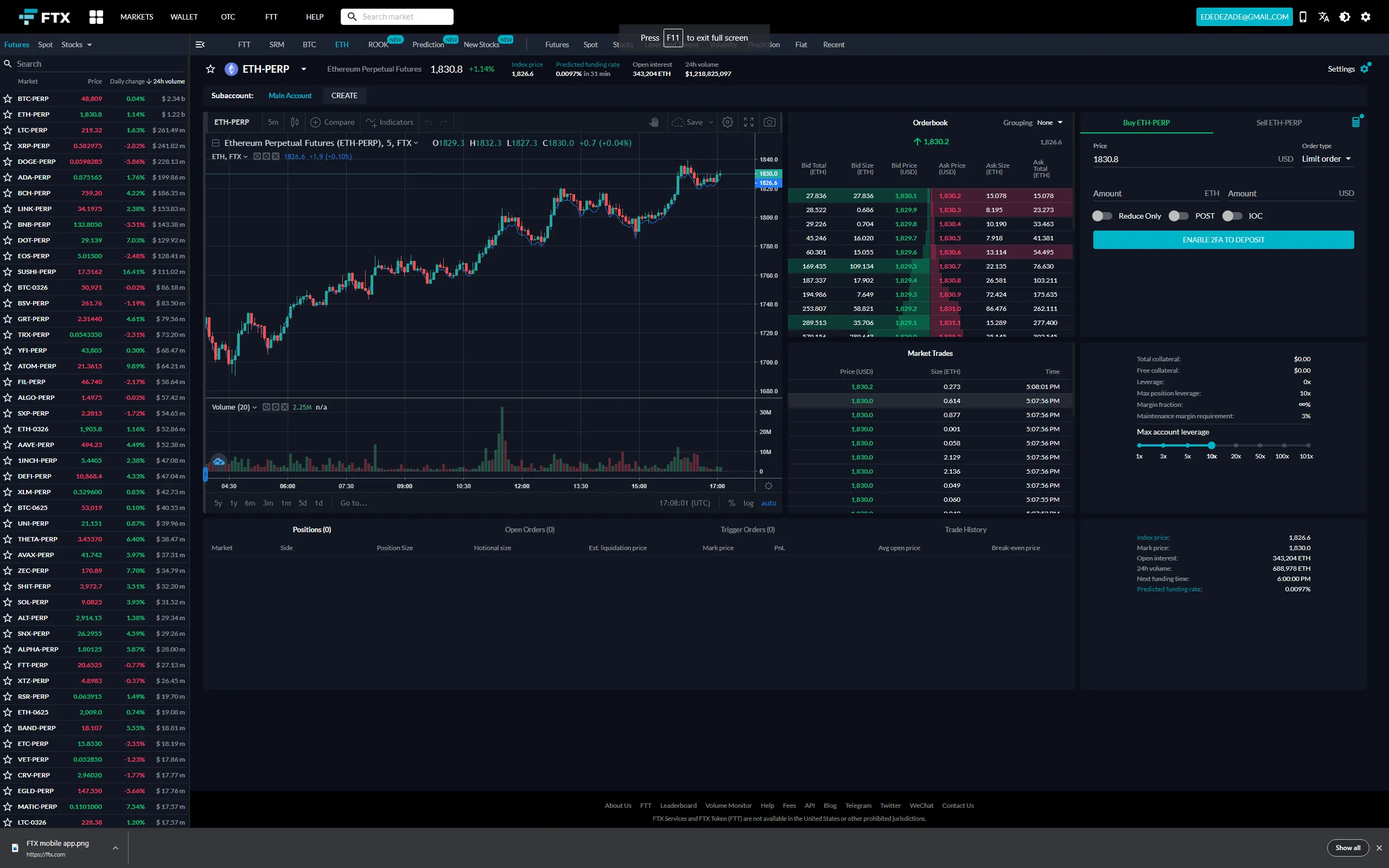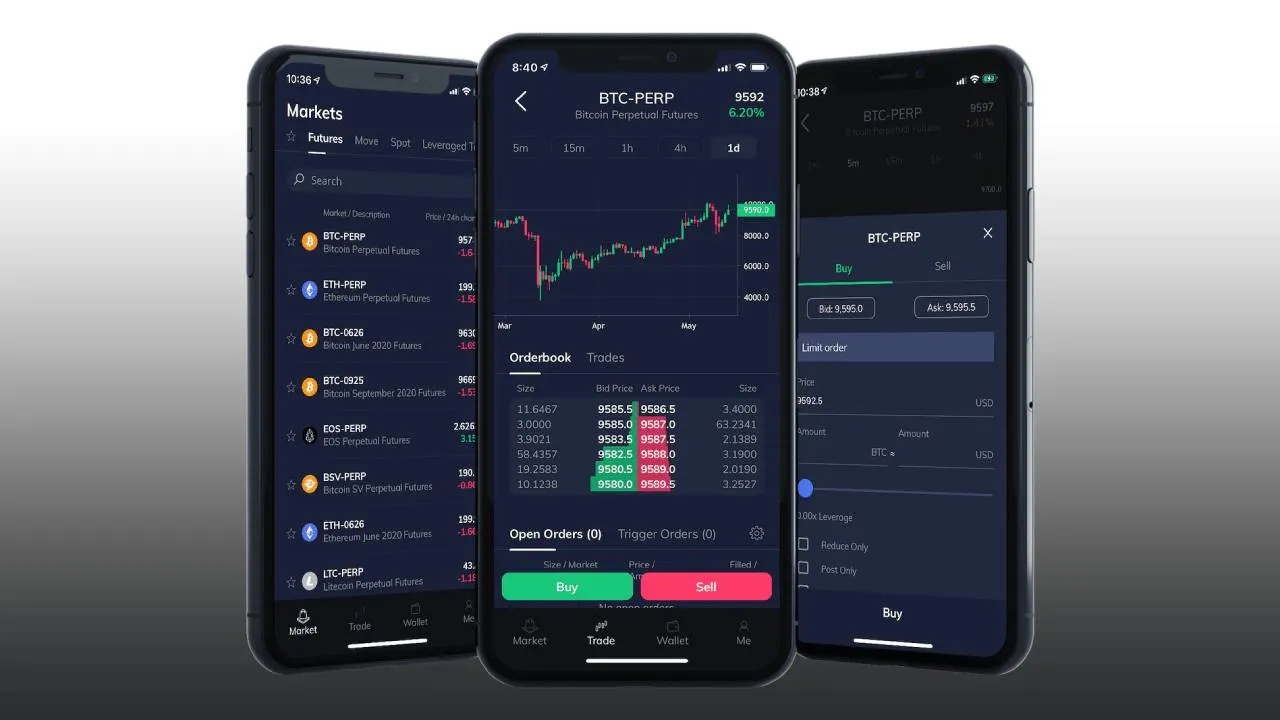In brief
- FTX is one of the top crypto derivatives exchanges in the world.
- Derivatives exchanges enable users to trade contracts on crypto assets, or buy tokens representing other assets or funds.
- Although FTX is a well-designed platform, it's firmly aimed at experienced traders.
If you’ve dabbled in the crypto space as a trader for a while now, then chances are you’ve used a fair few cryptocurrency exchanges.
While there are many different options, from centralized offerings such as Coinbase and Binance, to decentralized exchanges (DEXs) like Uniswap and Binance DEX, FTX offers something rather different.
What is FTX?
Launched in May 2019, FTX is an exchange that was, in its own words, built by traders, for traders. The exchange itself is a cryptocurrency derivatives exchange (more on that in a sec) which offers its users a variety of innovative and unique trading options, some of which can’t be found elsewhere, with higher risks and rewards to match.
In December 2019 it received a large investment courtesy of exchange giant Binance.
As one of the top crypto derivatives exchanges in the world FTX offers bags of options for its users, so we took it for a spin to see what it’s made of. Before we dive into the details though, let’s clear up one key thing...
What are crypto derivatives?
We could easily spend an entire article going into the ins and outs of crypto derivatives, but that’s beyond the scope of this review. In short, derivatives are financial assets that derive their values from underlying products; in this case, cryptocurrencies.
Derivatives exchanges like FTX enable users to trade contracts on these assets rather than the assets themselves, or buying tokens which represent other assets or funds. A few trading options are available, some of which are futures. These are an investment which provides users with an obligation to buy or sell assets at an agreed future date.
In the crypto world, futures are often used to trade assets with leverage, resulting in borrowing capital to increase your position size. This can increase the potential profits, but can also result in devastating losses. Indeed, the UK's Financial Conduct Authority has banned the sale, marketing and distribution of crypto derivatives for retail investors, arguing that consumers could suffer “harm from sudden and unexpected losses”.
FTX lets users use up to 101x leverage on most future contracts; for comparison, Bitmex offers 100x while Binance bumps this up to 125x. In addition to futures, FTX also offers lots of other trading features, including options, volatility products and leveraged token, as well as unique MOVE contracts—futures that expire to the amount that BTC’s price has moved, rather then the price itself.
Essentially there’s a ton of trading options available, each with its own nuances and details to take into account, so we’d recommend doing your own research and diving into FTX’s comprehensive guide section.
Design and UX
The second you load up FTX it’s clear that you’re looking at an incredibly polished site, with a clean design and clearly marked sections. The layout on the main exchange is intuitive to anyone that’s used regular exchanges before, and access to important functions like settings and security is clearly-labeled.

Despite looking incredibly slick though, there’s no denying that beginners will feel immediately out of their element from the second they’re greeted with the main page. Futures, Spot, Stocks, Leveraged Tokens, Volatility and more are all staring at you from the get-go—rather intimidatingly too, we might add.
This isn’t a critique on the site’s design, but more a way to drive home a point. If your crypto exchange experience to date has only involved buying and selling assets on standard exchanges, you’ll be in for a sharp learning curve on FTX. If you’re motivated to learn more, though, then all the tools are clearly laid out for you to take them on when ready.

The FTX smartphone app (available on Android and iOS) is just as polished as its desktop brother, offering a slick experience if you’re trading on the move.
Getting started with FTX
First things first—US users will need to register on ftx.us, while other supported countries can head on over to ftx.com.
Signing up to the site is a breeze, requiring you to enter your email and create a password. One feature we rather like is the in-built password strength checker, which refuses to let you create an account until you enter a password that’s secure. If you’re lazy with passwords this might be annoying, but it’s about high time you chose something secure, especially when it comes to a website where you’re dealing with financial assets.
While you don’t need to supply ID like a passport or driving license, you’ll be limited to withdrawing just $1,000 if you don’t. Verifying your ID will not only let you withdraw more, but it’ll also increase your account’s security. You’ll need a bank statement or utility bill to verify your address, and once you’re set up you’ll have unlimited withdrawals.
FTX fees and withdrawals
As with other derivatives platforms, FTX has a tier structure when it comes to its fees, based on traded volumes in USD. For most users, maker fees will be 0.02%, with taker fees at 0.07%. Professional traders can use a VIP program which has even lower fees for high-volume traders. This also includes a dedicated account manager.

Other fees can be found with leveraged tokens and redemption fees, which are 0.1%, while users trading with a 50x or 100x leverage on futures contracts will see increased trading fees of 0.02% and 0.03% respectively.
When it comes to withdrawing, you can’t send funds directly to a bank account unless you're verified to KYC level three. Until you've completed KYC verification, you’ll need to withdraw a USD stablecoin for a USD withdrawal, or send crypto assets to your own wallets. You’ll need to set up 2FA (two-factor authentication) for the withdrawal process using the service of your choice. It’s an extra step, but you’ll be thankful if your account is ever compromised and your funds remain safe.
The FTT token and insurance fund
FTX has its own ecosystem token called FTT that’s been specifically developed to act as a backbone of the exchange's ecosystem, similar to how BNB works on Binance. Holders of the FTT token have access to certain perks, which include the weekly buying and burning of fees, lower trading fees, and collateral for futures trading.
FTX will burn at least half of all FTT tokens, which will create a scarcer supply while increasing demand, and the token itself currently ranks well within the top 50 on CoinMarketCap at the time of writing. Crypto card provider Swipe has also teased an FTX card, although further details such as a release date—and whether it'll offer any perks for FTT token holders—have yet to be revealed.
Yesterday we burned another ~3 million USD worth of FTT
With this we have now burned over 10 million FTT
🔥🔥🔥https://t.co/1fCYVc7uao pic.twitter.com/OPCMHpO7gK
— FTX - Built By Traders, For Traders (@FTX_Official) February 17, 2021
FTX also has an insurance fund to prevent user losses in the case of huge, sudden market movements. Traders who make use of the 50x-100x leverage pay higher fees, which are then added to this fund. If FTX’s liquidation engine fails due to an event such as an unexpected drop in BTC, this insurance fund will be used to pay traders whose positions have been unfairly closed. Proceeds from these gains are shared among FTT holders, a feature known as socialized gains.
The 5.25 million FTT we put in our insurance fund in 2019 now makes the fund worth over 100 million USDhttps://t.co/tMYgJOAdqI pic.twitter.com/vQDkmkufD2
— FTX - Built By Traders, For Traders (@FTX_Official) February 14, 2021
Is FTX safe?
FTX is one of the largest crypto derivatives exchanges in the world, and is widely trusted to be safe and secure. Users can use 2FA to access their accounts and make withdrawals, making it particularly difficult for nefarious third parties to access funds.
FTX’s security policy also states that its team works closely with security researchers to detect potential vulnerabilities, while ensuring that services remain online and secure at all times.
Having said that, there’s no detailed breakdown of FTX’s security practices that go into its policies any further. To date, there’s been no breach or hack, but nothing is ever 100% foolproof.
Indeed, while FTX itself hasn't suffered any breaches, its subsidiary Blockfolio, a crypto portfolio tracker, was hacked in February 2021. FTX and Blockfolio CEO Sam Bankman-Fried explained that no features or funds were affected by the hack; Blockfolio's display and news sections were compromised, along with its communications platform Signal, which was used by the hackers to send offensive messages to users.
It's a salutary reminder to take advantage of all the security features available; it's also advisable to avoid leaving assets on an exchange for any longer than you need to, and instead use a private wallet such as a hardware wallet to store your funds.
Verdict
FTX is an incredibly well-built, thoughtfully designed exchange that offers an array of trading features—with some serving up higher risks and rewards than more traditional non-derivatives exchanges.
While it’s an easy site to use and navigate in terms of design, however, it’s not a service that inexperienced users can jump into. You’ll need quite a bit of time to read up on all of the services it offers, and to wrap your head around how everything works before dropping any cash.
Experienced traders, however, will feel right at home, and can take advantage of countless different ways to help rake in some profit. Just remember to play things sensibly, and never put in any amount you’re not comfortable losing.
Rating: 4/5
Disclaimer
The views and opinions expressed by the author are for informational purposes only and do not constitute financial, investment, or other advice.

